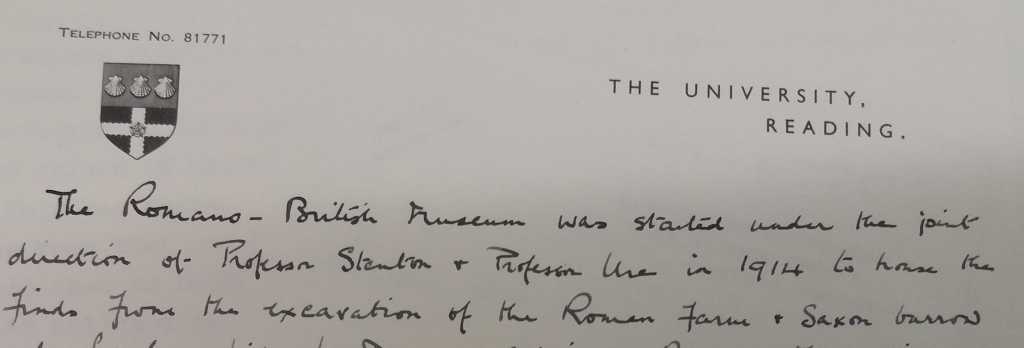By Amara Thornton (Research Officer, Ure Museum)
This month, the Ure Museum posted a new film on its YouTube channel, “On Museum Beginnings“. I put together this short film taking clips from a wonderful audio recording of the Ure Museum’s first curator, Annie Dunman Hunt Ure, giving a talk to the University’s Atrebates Society (for classics students) in the 1960s. Illustrating Annie’s words in the film are her photograph, from the Ure Museum’s photographic archive, and new photographs taken for the film of the Museum’s former home, Portland Place on London Road in Reading, and its home since 1957, the building on University of Reading’s Whiteknights Campus now known as Edith Morley.
Annie’s recorded talk contains valuable details about the history of Ure Museum. It had a number of names, but before University College Reading became the University of Reading in 1926, it was known as the “Museum of Archaeology” or “Museum of History and Archaeology”. The Ure Museum today is only part of this original museum.
Housed together with the Greek, Egyptian and Cypriot artefacts now at the Ure was a significant Romano-British collection – often referred to as “the Romano-British Museum”. This is noted in the College’s Annual Report for the 1919/1920 session, which records its acquisition of a lease for No 30 Portland Place, where
“a large room … has been equipped as a Museum of Archaeology. The collections which have thus been brought together include cases of Egyptian, Cypriote, and Greek antiquities, and a large mass of local objects that illustrate the history of the district from the stone age to that of the Anglo-Saxon conquest”.
Professor of Classics Percy Ure and Professor of History Frank Stenton were jointly responsible for this museum, which was run for both the Classics and the History Departments. Both Annie Ure and Doris (Parsons) Stenton were also involved in it. A few years later, the 1922/23 Annual Report records that with College leasing Nos. 24, 26, 28 in addition to No 30 at Portland Place, a new room was added to the Museum for “the previously scattered collection of Greek and Egyptian antiquities”.
The foundation collection of “the Romano-British Museum” came from a 1914 excavation at Lowbury Hill, near Cholsey (this village is now in South Oxfordshire, but before 1974 it was in Berkshire). The excavation was directed by Donald Atkinson, a colleague of Percy Ure’s in the Classics Department. In the Ure Museum archives are a few documents relating to the “Romano-British Museum” and the Lowbury Hill excavation, including a short history and a list of the excavation expenses.


Eventually, the Romano-British collections were given to the History Department. The reference that Annie makes in the film to the human remains discovered at Lowbury Hill indicates that when the History and Classics Departments moved into a new building on Whiteknights campus, the “Romano-British Museum” was located on the floor above the “Museum of Greek Archaeology”.
There will be more to come on the history of this “Romano-British Museum” but for now I hope you enjoy this taster “On Museum Beginnings”!
References/Further Reading
Atkinson, Donald. 1916. The Romano-British Site on Lowbury Hill in Berkshire. [University College Reading Studies in History and Archaeology]. Reading: University College Reading.
University College Reading. Session 1919-1920. Annual Report of the Council… Reading: University College Reading.
University College Reading. Session 1922-1923. Annual Report of the Council… Reading: University College Reading.

